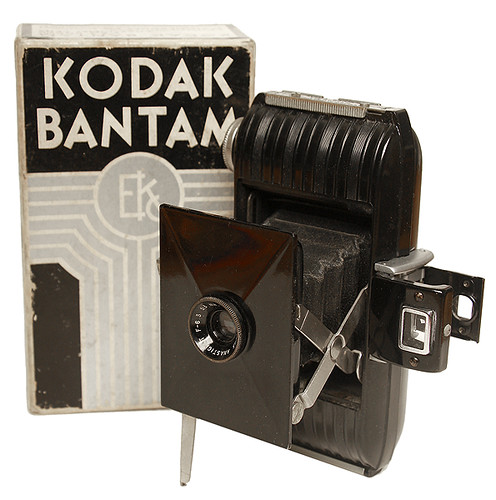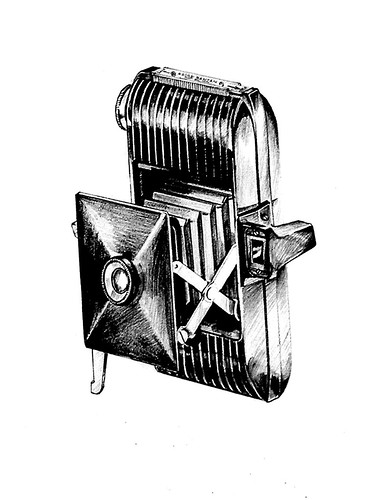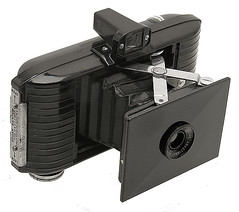Difference between revisions of "Kodak Bantam"
(+ wiki links to Special's own page) |
(bit of a re-organization, this primarily about the strut-folders) |
||
| Line 1: | Line 1: | ||
| − | {| | + | {{Flickr_image |
| − | || | + | |image_source= http://www.flickr.com/photos/ricksoloway/3726592468/in/pool-camerawiki |
| − | | | + | |image= http://farm3.static.flickr.com/2597/3726592468_1bca796175.jpg |
| − | || | + | |image_align= right |
| + | |image_text= Bantam f/6.3 with folding viewfinder | ||
| + | |image_by= Rick Soloway | ||
| + | |image_rights= with permission | ||
| + | }} | ||
| + | {{Flickr_image | ||
| + | |image_source= http://www.flickr.com/photos/ricksoloway/3425602138/in/pool-camerawiki | ||
| + | |image= http://farm4.static.flickr.com/3546/3425602138_e4c0df50c7.jpg | ||
| + | |image_align= right | ||
| + | |image_text= Design sketch by Walter Dorwin Teague | ||
| + | |image_by= Rick Soloway | ||
| + | |image_rights= with permission | ||
| + | }} | ||
| + | Because [[35mm film]] originated as a stock for movie cameras, a large fraction of its width is taken up with sprocket holes—not a requirement in a stills camera. Thus, [[Kodak|Eastman Kodak]] introduced an alternative "miniature" format, [[828 film]], consisting of paper-backed rolls 35mm wide, but having only one registration hole per image. This permitted an image area of 28×40 mm, increasing the image area nearly 30% compared to standard 35mm. | ||
| + | |||
| + | With this film, Kodak introduced a series of Bantam [[folding camera]]s of very compact design. The styling was by [[Walter Dorwin Teague]], one of his many notable designs for the company. The original Bantam of 1935 came in two versions: The basic model had a 1:12.5 Doublet lens and a single speed shutter. The higher-spec option had a 1:6.3 lens and a rigid finder. The strut-folding Bantams went through several variations. After 1938, the lens boards acquired a metal trim border; and another Teague body design with angled, rather than curved ends appeared. The top models in the range were outfitted with f/4.5 Kodak Anastigmat Special lenses. Finally in the post-WWII-period the Bantam was updated as the '''Flash Bantam Camera''', adding [[flash sync]] to the shutter. | ||
| + | |||
| + | Most Bantams were strut folders, but the [[Kodak Bantam F/8|Bantam F.8]] of 1938 had a rectangular pull-out lens tube instead. The luxurious [[Kodak Bantam Special|Bantam Special]] was launched in 1936, a top-quality [[rangefinder camera]] with "moderne" styling.The [[Kodak Bantam RF|Bantam RF]] designed by [[Arthur H Crapsey]] was added in 1953, not as new folder but as compact rigid body model for the advanced fan of the 28×40mm frame format. | ||
| + | |||
| + | [[Kodak Ltd.]] in the UK introduced the [[Kodak Bantam Colorsnap|Bantam Colorsnap]] series from the mid-1950s to the mid-1960s—a quixotic bit of marketing which kept 828 alive for a few years longer, despite the increasing world domination of 135-format cameras. | ||
| − | |||
| − | |||
| − | |||
| − | |||
{|class="plainlinks" | {|class="plainlinks" | ||
|alight=center|[http://www.flickr.com/photos/ricksoloway/1418514976/ http://farm2.static.flickr.com/1319/1418514976_3ac5df0e8b_m.jpg]<br/>with rigid finder and f6.3 [[Anastigmat]] (1935) | |alight=center|[http://www.flickr.com/photos/ricksoloway/1418514976/ http://farm2.static.flickr.com/1319/1418514976_3ac5df0e8b_m.jpg]<br/>with rigid finder and f6.3 [[Anastigmat]] (1935) | ||
| − | |||
| − | |||
|align=center|[http://www.flickr.com/photos/n6nkn/154234717/in/pool-camerapedia/ http://farm1.static.flickr.com/75/154234717_8069912437_m.jpg]<br/>Kodak Flash Bantam of 1947 | |align=center|[http://www.flickr.com/photos/n6nkn/154234717/in/pool-camerapedia/ http://farm1.static.flickr.com/75/154234717_8069912437_m.jpg]<br/>Kodak Flash Bantam of 1947 | ||
| Line 18: | Line 31: | ||
|colspan=2 align=center|[http://www.flickr.com/photos/captkodak/271872436/in/pool-camerapedia/ http://farm1.static.flickr.com/96/271872436_d6b4530da2.jpg]<br/>Bantam 4.5 of 1938 and Flash Bantam of 1947 | |colspan=2 align=center|[http://www.flickr.com/photos/captkodak/271872436/in/pool-camerapedia/ http://farm1.static.flickr.com/96/271872436_d6b4530da2.jpg]<br/>Bantam 4.5 of 1938 and Flash Bantam of 1947 | ||
| − | |||
|} | |} | ||
== Links == | == Links == | ||
| + | * [http://kodak.3106.net/index.php?p=209 Kodak 828 rollfilm cameras] at Michaël Koning's [http://kodak.3106.net/index.php Kodak Classics] | ||
* [http://www.pbase.com/equipment/3258 Bantam pictures] at [http://www.pbase.com/ pbase.com] | * [http://www.pbase.com/equipment/3258 Bantam pictures] at [http://www.pbase.com/ pbase.com] | ||
* [http://www.google.com/patents?id=PTBrAAAAEBAJ&dq=camera+inassignee:kodak&as_drrb_ap=b&as_minm_ap=2&as_miny_ap=1936&as_maxm_ap=9&as_maxy_ap=1936&as_drrb_is=q&as_minm_is=0&as_miny_is=&as_maxm_is=0&as_maxy_is= Design Patent - first Bakelite model] by [[Walter Dorwin Teague]] | * [http://www.google.com/patents?id=PTBrAAAAEBAJ&dq=camera+inassignee:kodak&as_drrb_ap=b&as_minm_ap=2&as_miny_ap=1936&as_maxm_ap=9&as_maxy_ap=1936&as_drrb_is=q&as_minm_is=0&as_miny_is=&as_maxm_is=0&as_maxy_is= Design Patent - first Bakelite model] by [[Walter Dorwin Teague]] | ||
Revision as of 22:20, 30 April 2011

|
| Bantam f/6.3 with folding viewfinder image by Rick Soloway (Image rights) |

|
| Design sketch by Walter Dorwin Teague image by Rick Soloway (Image rights) |
Because 35mm film originated as a stock for movie cameras, a large fraction of its width is taken up with sprocket holes—not a requirement in a stills camera. Thus, Eastman Kodak introduced an alternative "miniature" format, 828 film, consisting of paper-backed rolls 35mm wide, but having only one registration hole per image. This permitted an image area of 28×40 mm, increasing the image area nearly 30% compared to standard 35mm.
With this film, Kodak introduced a series of Bantam folding cameras of very compact design. The styling was by Walter Dorwin Teague, one of his many notable designs for the company. The original Bantam of 1935 came in two versions: The basic model had a 1:12.5 Doublet lens and a single speed shutter. The higher-spec option had a 1:6.3 lens and a rigid finder. The strut-folding Bantams went through several variations. After 1938, the lens boards acquired a metal trim border; and another Teague body design with angled, rather than curved ends appeared. The top models in the range were outfitted with f/4.5 Kodak Anastigmat Special lenses. Finally in the post-WWII-period the Bantam was updated as the Flash Bantam Camera, adding flash sync to the shutter.
Most Bantams were strut folders, but the Bantam F.8 of 1938 had a rectangular pull-out lens tube instead. The luxurious Bantam Special was launched in 1936, a top-quality rangefinder camera with "moderne" styling.The Bantam RF designed by Arthur H Crapsey was added in 1953, not as new folder but as compact rigid body model for the advanced fan of the 28×40mm frame format.
Kodak Ltd. in the UK introduced the Bantam Colorsnap series from the mid-1950s to the mid-1960s—a quixotic bit of marketing which kept 828 alive for a few years longer, despite the increasing world domination of 135-format cameras.
 with rigid finder and f6.3 Anastigmat (1935) |
 Kodak Flash Bantam of 1947 |
 Bantam 4.5 of 1938 and Flash Bantam of 1947 | |
Links
- Kodak 828 rollfilm cameras at Michaël Koning's Kodak Classics
- Bantam pictures at pbase.com
- Design Patent - first Bakelite model by Walter Dorwin Teague
- Design patent - 1938 model by Walter Dorwin Teague
- Repair notes in Daniel Mitchell's camera site
- Bantam in the Virtual Camera Museum at www.virtualcameramuseum.com
- Bantam Special, Bantam 5,6, Bantam Original, Bantam RF, Bantam Colorsnap on www.collection-appareils.fr by Sylvain Halgand
- Bantam 4,5 at Mark Hahn's [1]
- Flash Bantam on www.collection-appareils.fr by Sylvain Halgand
- Bantam Special at Gloriously Colorful Kodak's [2]
- Bantams at Mischa Koning's Kodak Classics [3]
- Bantam special at Au fil des images (in French)
